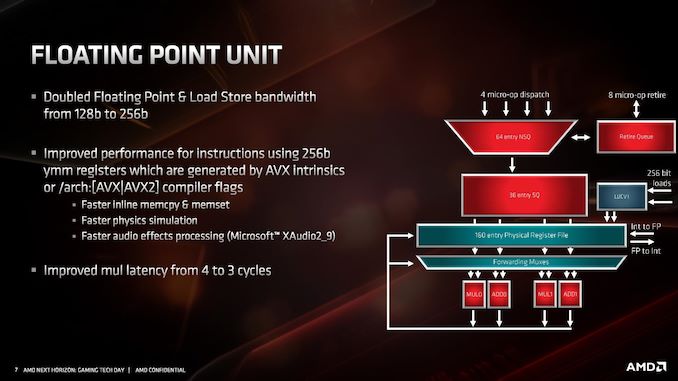AMD Zen 2 Microarchitecture Analysis: Ryzen 3000 and EPYC Rome
by Dr. Ian Cutress on June 10, 2019 7:22 PM EST- Posted in
- CPUs
- AMD
- Ryzen
- EPYC
- Infinity Fabric
- PCIe 4.0
- Zen 2
- Rome
- Ryzen 3000
- Ryzen 3rd Gen
Floating Point
The key highlight improvement for floating point performance is full AVX2 support. AMD has increased the execution unit width from 128-bit to 256-bit, allowing for single-cycle AVX2 calculations, rather than cracking the calculation into two instructions and two cycles. This is enhanced by giving 256-bit loads and stores, so the FMA units can be continuously fed. AMD states that due to its energy aware scheduling, there is no predefined frequency drop when using AVX2 instructions (however frequency may be reduced dependent on temperature and voltage requirements, but that’s automatic regardless of instructions used)
In the floating point unit, the queues accept up to four micro-ops per cycle from the dispatch unit which feed into a 160-entry physical register file. This moves into four execution units, which can be fed with 256b data in the load and store mechanism.
Other tweaks have been made to the FMA units than beyond doubling the size – AMD states that they have increased raw performance in memory allocations, for repetitive physics calculations, and certain audio processing techniques.
Another key update is decreasing the FP multiplication latency from 4 cycles to 3 cycles. That is quite a significant improvement. AMD has stated that it is keeping a lot of the detail under wraps, as it wants to present it at Hot Chips is August. We’ll be running a full instruction analysis for our reviews on July 7th.











216 Comments
View All Comments
The_Assimilator - Wednesday, June 12, 2019 - link
The original version of this article noted the 3950X price wasn't confirmed at the time of publication, but it seems they edited that bit out after Su's presentation.Still need the table to be updated - PCIe and DDR4 columns at least.
vFunct - Tuesday, June 11, 2019 - link
Eventually these Multi-chip packages should incorporate system DRAM (via HBM) as well as SSD NVRAM and GPUs, and sold as full packages that you'd typically see in common configurations. 64GB memory + 1TB SSD + 16 CPU cores + whatever GPU.mode_13h - Tuesday, June 11, 2019 - link
GPUs are often upgraded more often than CPUs. And GPUs dissipate up to about 300 W, while desktop CPUs often around 100 W (except for Intel's Coffee Lake).So, it wouldn't really seem like CPUs and GPUs belong together, either from an upgrade or a cooling perspective. Consoles can make it work by virtue of being custom form factor and obviously you don't upgrade a console's GPU or CPU - you just buy a new console.
Therefore, I don't see this grand unification happening for performance-oriented desktops. That said, APUs will probably continue to get more powerful and perhaps occupy ever more of the laptop market.
Threska - Tuesday, June 11, 2019 - link
I imagine that's why there's PCIe 4.0 and now 5.0.R3MF - Tuesday, June 11, 2019 - link
memory support?3200 official, or higher...
SquarePeg - Tuesday, June 11, 2019 - link
According to AMD 3200mhz is officially supported but they (AMD) have had memory clocked to over 5000mhz. Infinity fabric will run 1:1 with up to 3733mhz ram but any higher and it splits to 2:1. AMD also said that they have found DDR4 3600 16-21-21 to be the best bang for buck on performance returns.R3MF - Wednesday, June 12, 2019 - link
cheersGastec - Wednesday, June 12, 2019 - link
But will those be 3200 MHz overclocked (XMP) or 3200 SPD?Cooe - Wednesday, June 12, 2019 - link
The latter. Only >3200MHz is now overclocked.Lord of the Bored - Tuesday, June 11, 2019 - link
That security slide, though...Most of a page of "N/A"
I love it.